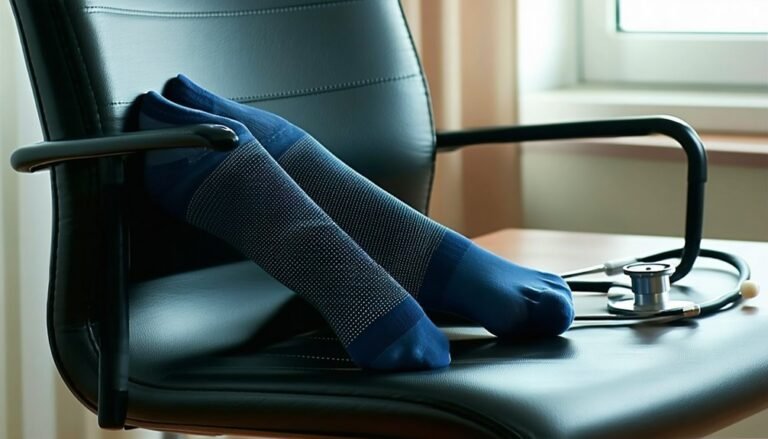Can Compression Socks Help With Neuropathy?
Compression socks can enhance venous return, potentially alleviating neuropathic symptoms like tingling and numbness through improved circulation. They offer graduated pressure, which may reduce edema and improve nerve function by optimizing blood flow and nutrient delivery. Selecting the correct compression level is vital, as it's tailored to individual needs to prevent skin irritation or impaired circulation. By maintaining proper fit and use, these socks could be a beneficial addition to your neuropathy management strategy. Explore further to understand your options.
Understanding Neuropathy and Its Symptoms

Neuropathy, often caused by diabetes, involves damage to the peripheral nerves, resulting in a range of symptoms that can severely impact quality of life. You might experience tingling, burning sensations, numbness, or even sharp pain, primarily in your hands and feet. Such nerve damage can lead to balance issues and increased risk of falls, posing a substantial safety concern. Clinically, neuropathy requires prompt attention to minimize complications.
For symptom relief, evidence-based strategies focus on managing blood sugar levels, which is essential for those with diabetes. Additionally, pharmacological interventions, including anticonvulsants and antidepressants, may alleviate pain. It's important to consult with healthcare professionals to develop a personalized treatment plan, ensuring safety and efficacy in mitigating nerve damage symptoms.
How Compression Socks Work
Although often associated with providing support to the legs, compression socks serve an important function in managing symptoms of neuropathy. The mechanism overview involves applying graduated pressure, which enhances venous return and reduces limb swelling. This compression can improve circulation by gently squeezing the leg tissues, promoting blood flow back to the heart. Various sock types are available—ranging from mild to firm compression levels. Your selection should be based on clinical recommendations and individual needs. It's vital to understand that not all compression socks are created equal. Some are designed specifically for neuropathic conditions, offering targeted support and pressure distribution. By choosing the appropriate type, you can guarantee ideal therapeutic efficacy while prioritizing comfort and safety in daily wear.
Potential Benefits of Compression Socks for Neuropathy
You'll find that compression socks can greatly improve blood circulation, which is essential for patients experiencing neuropathy. Clinical studies suggest these socks may help reduce swelling symptoms by promoting venous return, thereby alleviating discomfort. Additionally, by enhancing nerve function, compression socks could contribute to better overall limb health in neuropathic patients.
Improve Blood Circulation
When managing neuropathy, understanding the role of blood circulation is essential for symptom alleviation. Compression socks are designed to enhance blood flow, potentially offering circulation benefits that can mitigate neuropathy symptoms. They work by applying consistent pressure on your legs, which aids venous return and reduces vascular resistance. This mechanism can provide several advantages:
- Improved Blood Flow: By promoting efficient circulation, compression socks may help in delivering oxygen-rich blood to affected areas, supporting nerve health.
- Enhanced Venous Return: The graduated pressure design encourages the upward flow of blood, minimizing the risk of pooling in extremities.
- Reduced Risk of Complications: Consistent use can lower the likelihood of developing vascular complications associated with poor circulation, ensuring safer management of neuropathy symptoms.
These benefits underscore the potential safety and effectiveness of compression socks.
Reduce Swelling Symptoms
Swelling, clinically referred to as edema, often accompanies neuropathy and can exacerbate discomfort and pain. Compression socks provide a therapeutic benefit through graduated compression, which assists in swelling reduction by enhancing lymphatic drainage and venous return. The gentle yet firm pressure applied by these socks aids in minimizing fluid accumulation in the lower extremities, thereby contributing to pain relief.
Clinical studies have shown that consistent use of compression therapy can effectively minimize edema, guaranteeing improved comfort and mobility for individuals with neuropathy. By reducing the volume of interstitial fluid, compression garments decrease the risk of further complications associated with persistent swelling. When considering compression socks, it is crucial to consult a healthcare provider to ascertain the appropriate level of compression is safe and effective for your specific condition.
Enhance Nerve Function
While the primary function of compression socks is to manage swelling, they may also offer potential benefits in enhancing nerve function for individuals with neuropathy. Compression socks can aid in nerve regeneration by improving blood flow, thereby delivering essential nutrients required for nerve repair. This process can lead to sensory improvement, potentially reducing numbness or tingling sensations. Here's how compression can benefit you:
- Increased Circulation: Enhanced blood flow guarantees a steady supply of oxygen and nutrients, supporting nerve health.
- Reduced Inflammation: By minimizing swelling, there's less pressure on nerves, which can facilitate better nerve function.
- Improved Proprioception: Compression may help stabilize nerve signals, improving your ability to sense limb position and movement, vital for safety and mobility.
Make sure you consult a healthcare provider before use.
Limitations and Considerations

Despite their potential benefits, compression socks for neuropathy come with certain limitations and considerations that must be acknowledged. It's essential to understand that these garments may have side effects, such as skin irritation or impaired circulation if improperly fitted. Before using them, seeking medical advice is imperative to guarantee they're suitable for your specific condition. Compression levels vary and must be tailored to individual needs, highlighting the importance of professional guidance. In addition, if neuropathy stems from conditions like diabetes, additional medical interventions will likely be necessary. Finally, while compression socks can aid in symptom management, they shouldn't replace thorough treatment strategies. Always prioritize a holistic approach that encompasses lifestyle modifications and adherence to prescribed medical regimens.
Choosing the Right Compression Socks
When selecting compression socks for neuropathy, you'll want to take into account the appropriate compression level, as it's vital for optimizing blood flow without compromising comfort. Evidence suggests that a compression level of 15-20 mmHg can be beneficial for managing mild symptoms, while higher levels may be necessary for more pronounced cases. Additionally, choosing the right material and design is essential; breathable fabrics and seamless construction can reduce irritation and provide better support for sensitive skin.
Compression Level Importance
Selecting the appropriate compression level is essential for individuals with neuropathy to guarantee therapeutic efficacy and comfort. Compression levels are measured in millimeters of mercury (mmHg) and dictate the pressure exerted by the socks. For neuropathic patients, the selection process should prioritize both compression benefits and safety.
Consider these factors when choosing compression levels:
- Mild Compression (15-20 mmHg): Suitable for neuropathy patients seeking light pressure, enhancing circulation without causing discomfort.
- Moderate Compression (20-30 mmHg): Offers increased support, beneficial for reducing edema and managing more pronounced symptoms.
- Firm Compression (30-40 mmHg): Recommended under medical supervision, this level addresses severe symptoms but requires careful monitoring to prevent adverse effects.
Choosing the correct compression level maximizes therapeutic outcomes while mitigating any risk of compromising vascular health.
Material and Design Choices
While selecting compression socks, understanding material and design choices is vital for optimizing therapeutic benefits for neuropathy patients. Fabric types such as nylon and spandex offer elasticity and durability, contributing to effective compression. Design features like seamless construction minimize irritation, critical for sensitive neuropathic skin. Evaluate moisture-wicking properties to prevent fungal infections and guarantee skin integrity.
Here's a concise comparison of key attributes:
| Fabric Types | Design Features | Clinical Benefits |
|---|---|---|
| Nylon/Spandex | Seamless Construction | Reduces skin irritation |
| Cotton Blend | Moisture-Wicking | Prevents fungal infection |
| Wool | Padded Footbeds | Enhances comfort |
Guarantee the socks are appropriately sized to avoid constriction, which might exacerbate symptoms. Selecting the right combination of these variables can enhance safety and efficacy for neuropathy management.
Integrating Compression Socks Into Your Routine
To effectively incorporate compression socks into your daily regimen for managing neuropathy, it's vital to contemplate several key factors. Prioritize daily usage to maximize therapeutic benefits while maintaining venous return and minimizing neuropathic symptoms. Sock maintenance guarantees durability, preventing elasticity degradation and maintaining therapeutic compression levels. Consider these steps:
- Gradual Adaptation: Begin with limited wear time, progressively increasing duration to acclimate your lower extremities to the pressure.
- Quality Maintenance: Regularly inspect your socks for wear and tear. Hand wash with mild detergent to preserve elasticity and compression efficacy.
- Clinical Consultation: Engage with healthcare providers to tailor compression levels and confirm suitability, especially if you experience any adverse effects.
Adhering to these guidelines can enhance safety and optimize neuropathy symptom management.
Frequently Asked Questions
Are There Any Side Effects of Wearing Compression Socks?
When wearing compression socks, you're exposed to potential discomfort if compression levels aren't appropriate. Too tight socks may cause skin irritation or restrict blood flow. Always consult a healthcare professional to guarantee safe, evidence-based use tailored to your needs.
Can Compression Socks Be Worn Overnight?
You can wear compression socks overnight, but it's vital to make sure they're properly fitted. Nighttime usage may enhance circulation improvement, but it's important to consult a healthcare professional to assess individual risks and guarantee safety.
Do Compression Socks Come in Different Styles or Colors?
Imagine a rainbow in your sock drawer. Compression sock styles and colors vary widely, ensuring clinical efficacy doesn't compromise your aesthetic preferences. They're designed to enhance circulation safely, providing both therapeutic benefits and a splash of style.
How Do I Clean and Maintain Compression Socks?
To clean compression socks, use gentle detergent and cold water, either handwash or machine on delicate. For maintenance, air dry them flat to maintain elasticity. Regularly inspect for damage to guarantee they provide ideal therapeutic pressure and safety.
Are There Alternatives to Compression Socks for Neuropathy Relief?
You're exploring neuropathy treatments, and alternative therapies may include physical therapy, medications, or lifestyle changes. Clinical evidence supports options like TENS units or acupuncture. Always consult healthcare professionals for safe, effective management tailored to your condition.







